SEE ALSO: AN ANTI-GRAVITY PLATFORM OF V. S. GREBENNIKOV From N.E.T. 2005 magazine #3
SEE ALSO: APPLICATION OF A POLARIZATION MODEL OF HETEROGENEOUS PHYSICAL VACUUM TO BIOLOGY
Since 9.01.2000 You are a visitor No

Full English version of this text now is available at krepelka/greb.html
NATURAL PHENOMENA OF BIOLOGICAL ANTIGRAVITATION ASSOCIATED WITH INVISIBILITY IN INSECTS & GREBENNIKOV'S CAVITY STRUCTURAL EFFECT
("Flight" - Chapter Five from the book "MY WORLD" by Viktor S. Grebennikov )
In the spring of 2001 Viktor S. Grebennikov has died.
The eternal memory of this uncommon scientist - naturalist will remain in our hearts.
The introductory comment by Juri N. Cherednichenko (Laboratory of biophysics Scientific Research Institute of General Pathology and Human Ecology SB Russian Ac. Med. Sci. Novosibirsk-city)
Viktor S. Grebennikov is the scientist - naturalist, professional entomologist, gifted painter and, on the whole, comprehensively well-educated specialist with a wide spectrum of interests. For many people and scientists in Russia he is well-known as discoverer of cavity structural effect (CSE). But is far from being all are acquainted with his other opening, also borrowed from among concealed secrets of living Nature. In 1988 he found out antigravitational effects of chitinous shells of some insects species. But the most astonishing attendant phenomenon associated with antigravity was a phenomenon all on its own either partial invisibility, or deformed visual perception of the material object which was located in a zone of nulled gravitation. Based on this opportunity and by using bionics principles, the author designed and built an antigravitational platform, and also developed principles of practical manned flight with the speed up to 1,500 km/hr. Since the years 1991-92 years the device was used by the author as a means of rapid transport.
There is a well known wide spectrum of the natural phenomenology biogravitational effects, apparently, appropriate not only some species of insects. For example, there are numerous experimentally controlled cases of weight decrease in material objects under directed human psychokinetic influence, yogi's levitation in the states of deep transcendental Maharishi's meditation, mediums' levitation or even total disappearance in some rare spiritualistic communication sessions etc.
But it would be a mistake to think that similar opportunities are granted only to naturally gifted people. It is my belief it's a general biological law which insufficiently investigated. As is known, in somnambulistic (sleep-walking) condition, human weight is considerably reduced. So, somnambulist, which have body weight up to 80 - 90 kg in normal, during the night-travels can pass over a thin wooden bar; step on people, lie down in a neighbour bed, which haven't feeling physical pressure (except for a fright). Some clinical cases of genuine epilepsy during small attack (petite mal) someone have result in short-term convertible personality transformation (which sometimes in the people named as possessed by evil spirit), when slender girl, exhausted by illness, or 10 years old boy, suddenly gains a physical ability like a trained athlete. Now this psychophysiological phenomenon was named multiple personality, since it considerably differs from classical variants epileptic syndrome. Such clinical cases are well known and are wide described in literature. However, the phenomena accompanying the change in weight of objects or human bodies doesn't occur only during pathological conditions. Healthy people in conditions of acute emotional stress, connected with threat to life or dominant motivation of urgency achievement any vital purpose, are capable involuntarily to overcome obstacles, insurmountable under normal conditions; to lift huge weights etc. Usually this is explained as extreme mobilization muscular forces, though the exact calculation will not be correlated to the similar assumptions. Apparently, the biogravitational mechanisms are especially advanced in the sportsmen (high jumpers, weight-lifters, sprinters and long-distance runners). The productivity of their sports achievement in many respects (if not basically) is determined by psychological training, but not so much depend on physical status. If the correct scientific research problem of the human weight anomalies in various psychophysiological states was put and the equipment of dynamic monitoring of weight was created, we have received the quite objective information on this unusual phenomenon. The phenomena, short-term increase of weight of biological objects (including the men), which have been not connected with mass carry are known also.
The V.Grebennikov's book is written in highly artistic style and was illustrated by author himself. It content is peculiar "fingerprint" of spiritual wealth system, ecological ideology and author's entomological autobiography. Certainly, by many readers the book will be perceived, no more than popular general conclusion of 60-year's experience of specialist in the field of insects's world secrets, embellished by elements of a science fiction. But this is deep mistake. Being well familiar with V.Grebennikov and his works not by hearsay (and we live no more than in 10 kms from each other), I can tell, that I did not see more scientific diligent and truthful researcher and talented, qualified experimenter.
Unfortunately V.Grebennikov and his pioneer works are well-known advantageously in so-called Russian scientific "underground" environment. But, the opening of such scale, on my deep belief, should not be buried in the manuscripts, only because a scientific pragmatism not for a while yet is at authority. So be it that this popular scientific book will be for this so called "scientists" "science fiction". At everyone his faith, but just one trouble if his faith is blind. But having eyes - will see.
????? ???? ??????? ????????? ???????????????? ????? ???? ??????
("Polet" - V glava iz knigi V.S. Grebennikova "MOJ MIR")
Vesnoj 2001 g. ushel iz zhizni Viktor Stepanovich Grebennikov.
Vechnaya pamyat' ob `etom vydayuschemsya uchenom-estestvoispytatele ostanetsya v nashih serdcah.
Vstupitel'nyj kommentarij YU.N. CHerednichenko, st. n.s. laboratorii biofiziki NII Obschej patologii i `ekologii cheloveka SO RAMN
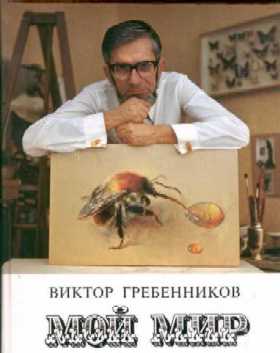
Viktor Stepanovich Grebennikov - naturalist and a professional entomologist. He is also an artist and an intellectual with a wide range of interests and pursuits. He is known to many as the discoverer of the Cavity Structures Effect (CSE). But very few people are familiar with his other discovery, the one that also borrows from Nature and its innermost secrets. He has discovered antigravitational effects of the chitin shell of certain insects back in 1988 but, the most impressive concomitant phenomenon he has discovered at the same time was that of complete or partial invisibility and/or of distorted perception of material objects entering the zone of compensated gravity. Based on this discovery, Victor Grebennikov used bionic principles to design and build an anti-gravitational platform for hovering flights at the speeds of up to 25 km/min. Since 1991-92 he has used this device for his own fast transportation.
Bio-gravitational effects are a wide spectrum of natural phenomena, apparently not confined to just a few species of insects. There is much empirical data to support the possibility of a lowered weight or complete levitation of material objects as a result of directed psycho-physical human action (psychokinesis) e. g. levitation of yogi practicing transcendental meditation according to the Maharishi method. There are known cases of mediums levitating during spiritistic sessions. However, it would be a mistake to think that such abilities are only found in people who are gifted by nature. I am convinced that these abilities are an understudied biological regularity. As is known, human weight significantly drops in the state of somnambulistic automatism (sleepwalking). Average 80-90 kg sleepwalkers are able to tread on thin planks, or step on people sleeping next to them without causing the latter any physical discomfort other than fright during their nocturnal journeys. Some clinical cases of non-spasmodic epileptic fits often result in a short-term reversible transformation of personality (people in such state are commonly referred to as "possessed"), whereby a skinny, exhausted girl or a ten year old boy may acquire the physical prowess of a trained athlete. This psychological phenomenon is currently known as the multiple personality syndrome, because it significantly differs from the classical complex of epileptic symptoms. Such clinical cases are well known and well documented. However, phenomena accompanied by a change in the weight of humans or of material objects are not confined to functional pathologies of the organism. Healthy people in the state of acute psychological stress caused by a life threatening situation or an overpowering motivation to achieve a vitally important goal have the ability to spontaneously overcome obstacles insurmountable in their normal condition. People in such situations are able to lift enormous weights etc. These phenomena are commonly explained by an extreme mobilization of muscular strength, but precise calculations do not agree with such hypotheses. Apparently, athletes (high jumpers, weightlifters, runners) have particularly developed bio-antigravitational mechanisms. Their athletic performance is mostly (if not wholly) determined not so much by the rigor of their training as by their psychological preparedness. If an accurate scientific task of studying the anomalies of the human weight in various psycho physiological states were ever set up and a technical means of dynamic weight monitoring created, we would then have objective data on this unusual phenomenon. There is also evidence of other phenomena of short-term mass increase in biological objects, including humans, that are not related to mass transfer.
V. S. Grebennikov's book has high literary merit and includes the author's own illustrations. It is a kind of a "fingerprint" for his system of spiritual values, his environmental outlook, and his entomological autobiography. Many readers are likely to perceive the book as nothing more than a popularized summary of the entomologist's 60 year experience of scientific observations, peppered with some elements of science fiction. But, such a conclusion would be deeply erroneous. As Viktor Stepanovich's friend and as someone with an intimate knowledge of his work (our homes are only 10 km apart), I can vouch that I have never met a more careful, conscientious, honest, and talented experimental scientist.
V. Grebennikov is also widely known in the so-called scientific underground, which is the branch of advanced Russian science constantly persecuted by the official scientific establishment. An establishment committee for combating of "pseudo science", created in Novosibirsk division of the Russian Academy, has victimized many talented members of our local scientific community. The situation is much the same at the Russian Agricultural Academy. It is very easy to lose one's job at a lab, even as its head, regardless of one's degree and title. One only needs to publish an article on, for example, the evolutionary significance of anti gravitational mechanisms in insects.
But, I am convinced that discoveries of such proportions must not be buried in manuscripts just because pragmatism still rules science. Let this book be nothing but "science fiction" for those at the top. Each person has his own beliefs but, he who has eyes shall see. Catastrophism in both, the evolution of living nature and in the nature of human knowledge, is actually a drastic destruction of old belief systems, a destruction that runs ahead of theoretical prognostications. A fanatical faith and worship of idols links our contemporary academic science with pagan religion. Yet, a harmonious development (in the sense of Pavel Florensky's pneumatosphere) would not be possible without breaking of the old stereotypes in the process of mastering the wisdom and experience of older generations.

Chapter V, FLIGHT
It is a quiet evening in the steppe. The red disk of the sun has already touched the faraway, misty horizon. It's too late to get back home. I've stayed too long here among my insects and I am getting ready to spend the night in the open. Thank goodness, I still have some water in the field bottle. I also have some mosquito repellent left and one really needs it here, with the hosts of gnats on the steep shores of this salty lake.
I am in the steppes of Kamyshlovo valley. The valley used to carry a mighty tributary of the Irtysh river, but the plowing of the steppes and the deforestation of the hills has turned the river into a deep, broad gully speckled by a string of salty lakes like this one.
The evening is quiet and calm tonight. Pods of ducks gleam over the evening lake and I can hear sandpipers in the distance. The high, pearly sky stretches over the soothing world of the steppe. Oh, how good it is to be out here, in the open country!
I am ready to settle for the night on the very edge of the steppe on the grassy glade above the gully. I've spread out my coat on the ground and set the backpack down as my pillow, collected few dry cakes of cow manure and lit them up before lying down. The romantic, unforgettable smell of bluish smoke is slowly spreading across the dozing plane. I lie down on my simple bed, stretch my tired legs and anticipate yet another wonderful night in the open country. The blue smoke will take me quietly into the land of fairy tales as the night's drowsiness is overcoming me quite fast. I shrink to a very small size of an ant, then I grow enormous, the size of the whole sky and I am about to fall asleep. But why is it that these "pre sleep transformations" of my bodily dimensions are somewhat unusual today, so strong? A new sensation has mixed in, a sensation of falling as though the high cliff above the gully has been snatched away from under me and I were falling into an unknown, terrible abyss!
Suddenly, I see flashes in front of my eyes and I open them but, the flashes would not disappear. They keep dancing on the pearly silver evening sky above and on the grass around me. I can feel a strong metallic taste in my mouth, as though I have pressed my tongue to the contact plates of a small electric battery. My ears have started ringing and I can distinctly hear the double beats of my own heart.
How can one sleep when such things are going on!
I sit up and try to drive away these unpleasant sensations but, nothing comes out of my efforts. The only result is that the flashes are no longer wide and blurred but, they became sharp and clear now, like sparks or perhaps small arcs and they make it difficult for me to look around. Now I remember. I had a very similar experience a few years ago in Lesochek [Little Grove], or to be more precise in the Enchanted Grove [the author is referring to localities of an entomological preserve in Omsk Region]. I have to get up and go for a walk around the lake shore. Does it feel like this everywhere around here? No. I feel a clear effect of "something" only right here, a meter from the edge of the cliff, while the effect clearly disappears ten meters further into the steppe. It gets a bit frightening. I am alone in the deserted countryside, by the "Enchanted Lake". I should pack up quickly and clear out but, my curiosity takes over me. What is this, really? Could it be that the smell of the salty lake water and the rotting slime would do this to me? I slid down down the cliff side under the steppe and sit down by the edge of the water. The thick, sweetish smell of sapropel and the rotting remains of algae has enveloped me like the mud in a spa. I sit there for five, may be ten minutes with no unpleasant sensations. It would be much better to sleep here, only if it weren't so damp. I climb back up onto the plane of the steppe and the same old story repeats! My head begins to spin and I get that galvanic, sour taste in my mouth again and I feel as though my weight were constantly changing. I feel incredibly light at one moment and unbearably heavy the next and the same streaks of light flash in my eyes as before. If this were indeed a "bad spot", some nasty anomaly, then no grass would grow here and the large bees would not be nesting just below in the loamy edge of the cliff. Yet, their nests are all over the place and in fact, I had made my bed right above their underground "bee cities", with their multitude of tunnels and chambers whose depths harbor so many larvae and cocoons, all
of them alive and thriving. Albeit, I understood nothing at this time and I got up from my unpleasant bed with a headache long before the sunrise and hobbled off, all tired, toward the road to catch a hitch to Isilkul.
I have visited the "Enchanted Lake" four more times that summer at various times of the day and under various weather conditions. My bees got incredibly busy toward the end of the summer stuffing their holes with pollen of the wild flowers and apparently feeling excellent. That was not my case though, while standing about a meter off the cliff edge above their nests. The set of the most unpleasant sensations would again settle in me, right here, while there would be none some five meters away and I feel the same old bewilderment: Why? Why do these bees feel so good here, feel so great that the entire cliff is drilled with their holes like a Swiss cheese and in places looking almost like a sponge?
The solution to this has come to me many years later, when the bee city in Kamyshlovo Valley has long since disappeared. The tillage reached the very edge of the cliff. Its top has consequently dropped off and what used to be a hard earthen bank with its bee nests and grassy top has turned into an atrocious and ugly, muddy slide.
But I had a handful of old clay lumps, the fragments of the nests with their multiple chamber cells, back at my home. Their side by side cells
reminded me of small thimbles, or little jugs with narrowing necks. I already knew that these bees were of the quadruple ring species, with 4 light rings on their elongated bellies. I had a wide container filled with these spongy clay lumps on my equipment cluttered desk, along with ant and grasshopper houses, bottles with chemicals and other assorted interesting stuff. I was about to pick something or another up and I moved my hand above these porous fragments.
A miracle! I had suddenly felt the warmth emanating from these remains. I've touched the lumps with my bare hand yet, they were cold. But, I could clearly feel the thermal sensation right above them. I could also feel some hitherto unknown jerks, some sort of "tick" in my fingers, besides the warmth. When I pushed the jar with the nests to the end of the desk and leaned over it, I had felt the same sensation in my head, the feeling,
which has overwhelmed me by the lake. I felt again as if I were getting lighter and bigger, with the vertigo of my body falling down. I saw the same rapid flashes of light in my eyes and my mouth had the electric battery in it again. I have also become a bit nauseous...
. I placed a sheet of cardboard over the jar, but the sensation wouldn't change. A have covered the jar with metallic pot lid but, it changed nothing either. It looked as if "something" was acting right through it. I was compelled to study the phenomenon at once but, what could I do at home, without any necessary physical instruments? The help came from many research scientists of various institutes of the Agricultural Academy in Novosibirsk. But alas, the instruments like thermometers, ultrasound detectors, magnetometers and electrometers did not respond to the nests in the slightest. We have conducted a precise chemical analysis of the clay and found nothing special. The radiometer was also silent, yet the ordinary human hands, and not only mine, would distinctly feel either warmth or cold, or a tingle, or sometimes a thicker, stickier environment. Some people's hands felt heavier, others felt lighter as if pushed up. Some people's fingers and arm muscles got numb, some felt giddy and developed profuse salivation. I could observe a similar phenomenon in a bunch of paper tubes inhabited
by leaf cutting bees. Each tunnel had a solid row of multi-layered "cans" made from torn leaves, covered with concave lids (also made from leaves). These cans contained silk, oval cocoons with larvae and chrysalides. I asked unsuspecting people who knew nothing of my discovery to hold their hands or faces over the leaf cutter nests and have made a detailed record of their replies in this experiment. Its results may be found in my article "On the physical and biological properties of pollinator bee nests" published in the Siberian Bulletin of Agricultural Science, no.3, 1984. The same article contains the formula of my discovery, a brief physical description of this wonderful phenomenon.
I have created a few dozen artificial honeycombs from plastic, paper, metal and wood, based on the structures of bee nests. It turned out that the cause of all those unusual sensations was not a biological field, but the size, shape, quantity and arrangement of cavities formed by and in any solid object. And as before, the organism felt it, while the instruments remained silent. I called the discovery the Cavity Structures Effect (CSE) and I have carried on with my experiments. Nature has continued to reveal to me its innermost secrets one after another. It has turned out that the CSE zone inhibits the growth of saprophytic soil bacteria, inhibits the growth of yeast and other similar cultures as well as it inhibits wheat grain germination. The behavior of microscopic agile chlamydospores also changes in this effective zone. Leaf cutting bee larvae begin to phosphoresce, while adult bees are much more active in this field and finish pollination two weeks earlier than they would otherwise. It has turned out that this CSE, same as gravitation, can't be shielded.





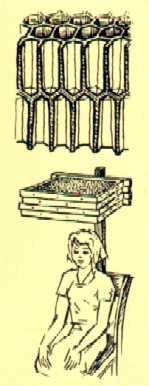


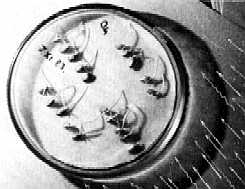 I have confirmed the latter conclusion by my many experiments on couching
wheat seeds in a strong CSE field, as compared to the seeds germinating in
the same climatic conditions but in the absence of the CSE field.
Photographs and drawings show both, the dying of roots in the experimental
batch as well as their sharp deviation in a direction away from my
artificial honeycomb. Therefore, the bees and the weeds back at the lake
had made a pact long ago and they are another example of the highest
ecological expediency of all being.
Yet, we see another example of people's merciless, ignorant and arrogant
attitude toward the nature in the very same location on this globe. The
bee city is gone now. Thick streams of fertile black soil run off down the
ruts in the former river bank cliff every spring. They run among filthy
heaps of trash to the lifeless, salty puddles left behind by once a living
river, which not too long ago was at least a string of lakes, with its
countless flocks of sandpipers and ducks, white swans, and hovering fish
hawks. Gone is the cliff, thinned out by bee holes, where one used to hear
the hum of hundreds of thousands of bees, which had led me for the first
time into the land of unknown.
I must have tired the reader out with all these honeycombs of mine. A
separate thick book would be required to describe all my experiments with
them. I will only mention one more thing. My battery powered pocket
calculator often malfunctioned in the CSE field. It either erred, or
sometimes its display window failed to light up for hours. I used the
field of a wasp nest combined with that of my two palms. None of these
structures had any effect on their own.
I have confirmed the latter conclusion by my many experiments on couching
wheat seeds in a strong CSE field, as compared to the seeds germinating in
the same climatic conditions but in the absence of the CSE field.
Photographs and drawings show both, the dying of roots in the experimental
batch as well as their sharp deviation in a direction away from my
artificial honeycomb. Therefore, the bees and the weeds back at the lake
had made a pact long ago and they are another example of the highest
ecological expediency of all being.
Yet, we see another example of people's merciless, ignorant and arrogant
attitude toward the nature in the very same location on this globe. The
bee city is gone now. Thick streams of fertile black soil run off down the
ruts in the former river bank cliff every spring. They run among filthy
heaps of trash to the lifeless, salty puddles left behind by once a living
river, which not too long ago was at least a string of lakes, with its
countless flocks of sandpipers and ducks, white swans, and hovering fish
hawks. Gone is the cliff, thinned out by bee holes, where one used to hear
the hum of hundreds of thousands of bees, which had led me for the first
time into the land of unknown.
I must have tired the reader out with all these honeycombs of mine. A
separate thick book would be required to describe all my experiments with
them. I will only mention one more thing. My battery powered pocket
calculator often malfunctioned in the CSE field. It either erred, or
sometimes its display window failed to light up for hours. I used the
field of a wasp nest combined with that of my two palms. None of these
structures had any effect on their own.
 But I have no wings. I stand suspended in the air supported in my flight
by a little flat, rectangular platform, which is slightly bigger than the
seat of a chair.
It has a pole with two handles onto which I hold and with whose help I
navigate this device. Is this some science fiction? I wouldn't say so.
The interrupted manuscript of this book had lied abandoned for two whole
years because our generous, ancient nature had given me another something
and again through my insect friends. As usual, it did it elegantly and
inconspicuously, yet swiftly and convincingly. The thrill of discovery
would not let go of me for two years, even though it seemed to me that I
was mastering it at a break-neck speed. But it always happens this way.
When your work is new and interesting, the time flies by at double its
normal speed.
The eye of the lake is already much closer. I can clearly see the highway
beyond by now and the match boxes have grown wheels on them. The highway
is about 8km away from the railway running parallel to it and if I look
closer, I can see the power line poles on the light gray moat of the
railway. It is time to turn some 20 degrees to the left. I can't be seen
from the ground and not just because of the distance. I cast almost no
shadow even in a very low flight.
Yet, as I found out later, people sometimes see something where I am in
the sky. I appear to them either as a light sphere, a disk, or something
like a slanted cloud with sharp edges, which moves strangly according to
them, not exactly the way a real cloud would. One person has observed a
"flat, non-transparent square, about one hectare in size". Could it have
been the optically enlarged little platform of my device? Most people see
nothing at all though and I am quite pleased with it for the time being. I
can't be too careful! Besides, I still haven't determined what my
visibility or invisibility depended on. I must confess that I consciously
avoid people when in flight and that I, for this very purpose, bypass all
cities and towns and try to pass even the cross roads and footpaths at
increased speed after making sure there is no one there.
But I have no wings. I stand suspended in the air supported in my flight
by a little flat, rectangular platform, which is slightly bigger than the
seat of a chair.
It has a pole with two handles onto which I hold and with whose help I
navigate this device. Is this some science fiction? I wouldn't say so.
The interrupted manuscript of this book had lied abandoned for two whole
years because our generous, ancient nature had given me another something
and again through my insect friends. As usual, it did it elegantly and
inconspicuously, yet swiftly and convincingly. The thrill of discovery
would not let go of me for two years, even though it seemed to me that I
was mastering it at a break-neck speed. But it always happens this way.
When your work is new and interesting, the time flies by at double its
normal speed.
The eye of the lake is already much closer. I can clearly see the highway
beyond by now and the match boxes have grown wheels on them. The highway
is about 8km away from the railway running parallel to it and if I look
closer, I can see the power line poles on the light gray moat of the
railway. It is time to turn some 20 degrees to the left. I can't be seen
from the ground and not just because of the distance. I cast almost no
shadow even in a very low flight.
Yet, as I found out later, people sometimes see something where I am in
the sky. I appear to them either as a light sphere, a disk, or something
like a slanted cloud with sharp edges, which moves strangly according to
them, not exactly the way a real cloud would. One person has observed a
"flat, non-transparent square, about one hectare in size". Could it have
been the optically enlarged little platform of my device? Most people see
nothing at all though and I am quite pleased with it for the time being. I
can't be too careful! Besides, I still haven't determined what my
visibility or invisibility depended on. I must confess that I consciously
avoid people when in flight and that I, for this very purpose, bypass all
cities and towns and try to pass even the cross roads and footpaths at
increased speed after making sure there is no one there.



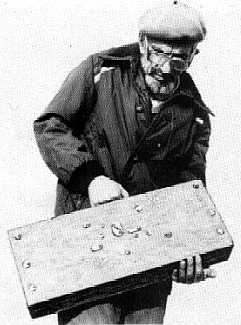
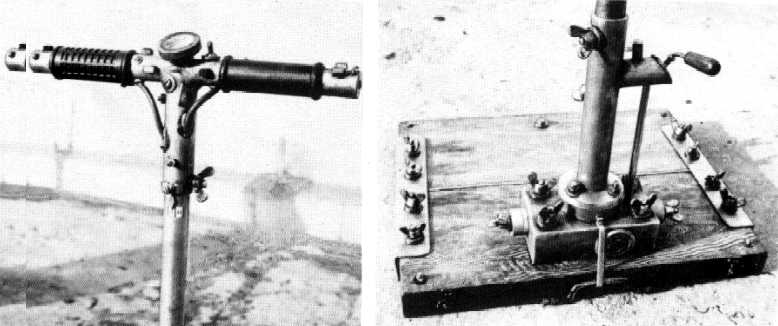

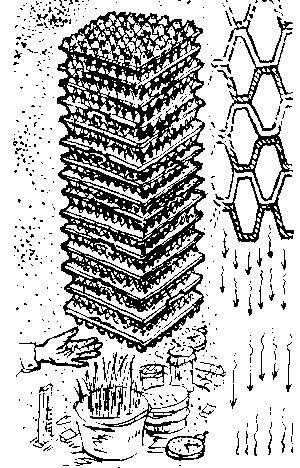 You will have large cells similar to the multi-cellular combs of a certain
"paper" wasp but, much bigger. Afix the whole set of cells (they can be
enclosed in a case) over the head of a person sitting in a chair with the
bottom "comb" about 10-20 cm above the head. Let the person sit there for
10-15 min. The "unnatural", unusual transformation of the spatial shape
formed by the set can be picked up even by the palm of your hand.
Experiment with sprouting seeds, or breeding microorganisms and insects
under the "macrocomb" and compare the results with those of identical
experiments conducted at least 2 m away from the comb. Repeat each pair of
experiments several times.
You will have large cells similar to the multi-cellular combs of a certain
"paper" wasp but, much bigger. Afix the whole set of cells (they can be
enclosed in a case) over the head of a person sitting in a chair with the
bottom "comb" about 10-20 cm above the head. Let the person sit there for
10-15 min. The "unnatural", unusual transformation of the spatial shape
formed by the set can be picked up even by the palm of your hand.
Experiment with sprouting seeds, or breeding microorganisms and insects
under the "macrocomb" and compare the results with those of identical
experiments conducted at least 2 m away from the comb. Repeat each pair of
experiments several times.
 Cut apart 6 sheets of office paper lengthwise and fold each of them like a
bellows so, that you get 10 edges and 20 planes on each. Squeeze the
bellows so that the sheets are square now, rather then rectangular and
glue them on top of one another, turning each consecutive sheet
horizontally 30 degrees clockwise against the bottom one. Then glue
together (preferably out of dark paper) a conical, multi-layered "flower"
with a few dozen petals and fluff up the petals. Test the emanators by
holding your palm above the "flower" and underneath the suspended bellows.
Place the bellows and then the flower above the head of a sitting person
and record his/her sensations.
Cut apart 6 sheets of office paper lengthwise and fold each of them like a
bellows so, that you get 10 edges and 20 planes on each. Squeeze the
bellows so that the sheets are square now, rather then rectangular and
glue them on top of one another, turning each consecutive sheet
horizontally 30 degrees clockwise against the bottom one. Then glue
together (preferably out of dark paper) a conical, multi-layered "flower"
with a few dozen petals and fluff up the petals. Test the emanators by
holding your palm above the "flower" and underneath the suspended bellows.
Place the bellows and then the flower above the head of a sitting person
and record his/her sensations.
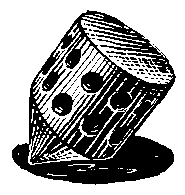 Their CSE field perception significantly increases when the top is
spinning. This is easily perceived by the palm of the hand and it is due
to the fact that the cavities must be numerically multiplying in space.
Their CSE field perception significantly increases when the top is
spinning. This is easily perceived by the palm of the hand and it is due
to the fact that the cavities must be numerically multiplying in space.
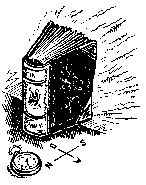 of a desk with its back facing the direction of the sun (north at night).
Open the book and fluff up its pages as evenly as possible. You should be
able to pick up some of the sensations mentioned in this chapter with your
palm, tongue, or back of your head in a few minutes (the CSE does not
appear immediately and it doesn't disappear immediately either). This
"stream" can be picked up at a 2-3 meters' distance after some practice.
It is also easy to verify that the "book CSE" is also non-screenable. You
can ask someone to stand between your hand and the book.
of a desk with its back facing the direction of the sun (north at night).
Open the book and fluff up its pages as evenly as possible. You should be
able to pick up some of the sensations mentioned in this chapter with your
palm, tongue, or back of your head in a few minutes (the CSE does not
appear immediately and it doesn't disappear immediately either). This
"stream" can be picked up at a 2-3 meters' distance after some practice.
It is also easy to verify that the "book CSE" is also non-screenable. You
can ask someone to stand between your hand and the book.
 simmilar cones were positioned against each other with respect to the sun,
one in Isilkul and the other one near Novosibirsk. They were thrown appart
and demolished on the moring of April 23, 1991. The one in Novosibirsk was
unfolded and pressed into the wall of an underground hiding place and its
magnets disappeared. Some residents of an Omsk apartment experienced a
series of strangest "poltergeists" (see Vechernii Omsk from April 26. and
Omsk and Moscow TV broadcasts) at the same moment. The same paper called
the device in the picture "Grebenikov's hyperboloid on August 5, 1991.
exactly because of this "coincidence". One of the "beams" of the upright
electronic waves between the two conical structures may have actually been
formed precisely there, on the river Irtysh embankment in Omsk.
simmilar cones were positioned against each other with respect to the sun,
one in Isilkul and the other one near Novosibirsk. They were thrown appart
and demolished on the moring of April 23, 1991. The one in Novosibirsk was
unfolded and pressed into the wall of an underground hiding place and its
magnets disappeared. Some residents of an Omsk apartment experienced a
series of strangest "poltergeists" (see Vechernii Omsk from April 26. and
Omsk and Moscow TV broadcasts) at the same moment. The same paper called
the device in the picture "Grebenikov's hyperboloid on August 5, 1991.
exactly because of this "coincidence". One of the "beams" of the upright
electronic waves between the two conical structures may have actually been
formed precisely there, on the river Irtysh embankment in Omsk.
 emanations, on a cobweb thread. Then I surrounded my above described
device with seven funnel-shaped rolls of film. As one straw is slowly
leaving the zone of impact of one roll, it will enter the power field of
another roll, then the third, and so on and the detector will keep
spinning. This experiment works the best in a sound-proofed chamber, away
from wires, pipes, sources of heat, cold and even bright light. There is
no miracle in it: matter is eternal in its endless movement.
emanations, on a cobweb thread. Then I surrounded my above described
device with seven funnel-shaped rolls of film. As one straw is slowly
leaving the zone of impact of one roll, it will enter the power field of
another roll, then the third, and so on and the detector will keep
spinning. This experiment works the best in a sound-proofed chamber, away
from wires, pipes, sources of heat, cold and even bright light. There is
no miracle in it: matter is eternal in its endless movement.
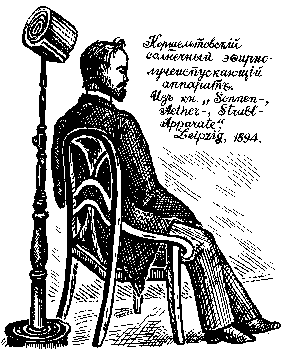 who discovered the CSE over 100 years ago and produced devices for its
practical application in medicine, agriculture and technology. Rhythmic
cavities were formed in them by copper chains. The devices were positioned
with their backsides facing the sun. It is indeed true that new inventions
are simply well forgotten old ones. The sensations described by Kornschelt
are identical to the ones, which I have experienced in my own, independent
work. I have learned about Korschelt's experiments only very recently,
from M. Platten's "New Medical Technique", vol. III, St. Petersburg, 1886,
where the following drawing of the device is reproduced.
who discovered the CSE over 100 years ago and produced devices for its
practical application in medicine, agriculture and technology. Rhythmic
cavities were formed in them by copper chains. The devices were positioned
with their backsides facing the sun. It is indeed true that new inventions
are simply well forgotten old ones. The sensations described by Kornschelt
are identical to the ones, which I have experienced in my own, independent
work. I have learned about Korschelt's experiments only very recently,
from M. Platten's "New Medical Technique", vol. III, St. Petersburg, 1886,
where the following drawing of the device is reproduced.
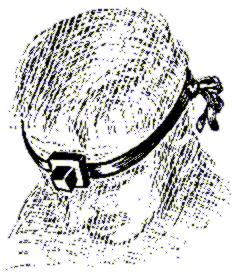 honeycombs, a grid of joined hands (more about it in the next chapter), a
sieve, an amulet otherwise known as tefelin. What is tefelin? It is an
old Jewish device. It is a tightly sown leather cube attached to a leather
platform with two bands. There are four tightly rolled and bleached, soft
kidskin strips of parchment with Talmudic inscriptions carved into the cube.
A worshipper attached the device to his forehead, with the axes of
parchment rolls perpendicular to the forehead and their outer ends facing
East. It turns out that the inscriptions are irrelevant. What matters is
the material and its shape and dimensions. When the device is made from
different materials it causes only unpleasant sensations, while a leather
tefelin produces a beneficial physiological effect. The microstructure of
the material must have a part in the CSE quality as well, besides the
shape and other such factors.
nepriyatnye oschuscheniya; kozhanyj zhe tefilin
honeycombs, a grid of joined hands (more about it in the next chapter), a
sieve, an amulet otherwise known as tefelin. What is tefelin? It is an
old Jewish device. It is a tightly sown leather cube attached to a leather
platform with two bands. There are four tightly rolled and bleached, soft
kidskin strips of parchment with Talmudic inscriptions carved into the cube.
A worshipper attached the device to his forehead, with the axes of
parchment rolls perpendicular to the forehead and their outer ends facing
East. It turns out that the inscriptions are irrelevant. What matters is
the material and its shape and dimensions. When the device is made from
different materials it causes only unpleasant sensations, while a leather
tefelin produces a beneficial physiological effect. The microstructure of
the material must have a part in the CSE quality as well, besides the
shape and other such factors.
nepriyatnye oschuscheniya; kozhanyj zhe tefilin
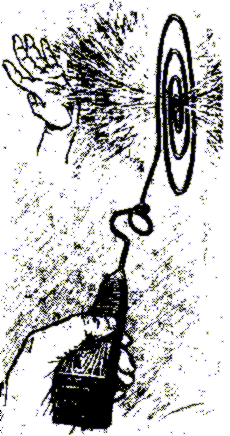 "accountant" of the soul's earthly deeds. This is the design of his staff.
A 2- or 3mm thick copper wire is twisted at the end into the shape of a
flat spiral, with 3-4 coils 10 cm in diameter. It has also 2 coils of
transverse, 3-dimensional spiral, each 5 cm in diameter, closer to the
handle. The wire is inserted into the 16 cm long, square-sectioned handle
made from dense wood. The handle is 4 cm thick at base and 1.5 cm thick at
its wire end. The entire staff with the wire coil is 41 cm long. The
narrow end of the handle has 13 deep bellow shaped notches.
The staff works even without the wire (albeit not as intensely). The wire
is thin and could be of any material. But, it works the best when it is
thickly insulated in two layers. This increases its effect. If you hold
the staff as demonstrated in the picture, the total radiation emanating
from the center of the large spiral, perpendicular to its surface, are
very well-perceivable by the human palm on both sides of the spiral. I
have never found out the purpose behind this ancient Egyptian tool and
what use they may have had for this "double-beam" emanator.
"accountant" of the soul's earthly deeds. This is the design of his staff.
A 2- or 3mm thick copper wire is twisted at the end into the shape of a
flat spiral, with 3-4 coils 10 cm in diameter. It has also 2 coils of
transverse, 3-dimensional spiral, each 5 cm in diameter, closer to the
handle. The wire is inserted into the 16 cm long, square-sectioned handle
made from dense wood. The handle is 4 cm thick at base and 1.5 cm thick at
its wire end. The entire staff with the wire coil is 41 cm long. The
narrow end of the handle has 13 deep bellow shaped notches.
The staff works even without the wire (albeit not as intensely). The wire
is thin and could be of any material. But, it works the best when it is
thickly insulated in two layers. This increases its effect. If you hold
the staff as demonstrated in the picture, the total radiation emanating
from the center of the large spiral, perpendicular to its surface, are
very well-perceivable by the human palm on both sides of the spiral. I
have never found out the purpose behind this ancient Egyptian tool and
what use they may have had for this "double-beam" emanator.
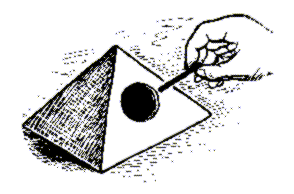 slanting its far end toward the bottom of the pyramid. "Stir" the
space inside the pyramid with the indicator, take it out and repeat the
procedure about 30 times. You will soon pick up an active zone, a "clot",
where the Egyptians had their tombs.
Another active zone (a flame) above the top of the pyramid is also
well-perceived by the indicator if you drag its end over the top. The
"clot" and the "flame" are well-felt by the finger inserted into he
pyramid, or your palm moved above it after some practice. The pyramid
slanting its far end toward the bottom of the pyramid. "Stir" the
space inside the pyramid with the indicator, take it out and repeat the
procedure about 30 times. You will soon pick up an active zone, a "clot",
where the Egyptians had their tombs.
Another active zone (a flame) above the top of the pyramid is also
well-perceived by the indicator if you drag its end over the top. The
"clot" and the "flame" are well-felt by the finger inserted into he
pyramid, or your palm moved above it after some practice. The pyramid
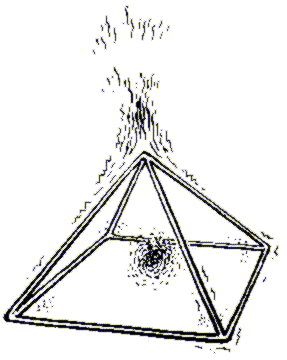
 pyramid to stop rotating. Cup your hands into a tube (see picture) and
point your hands from a 2-meter distance at the suspended pyramid (do not
lose your "target").
The pyramid will eventually start rotating clockwise in a few minutes
under the pressure of this beam of CSE energy. You can then stop its
rotation by moving the "tube" of your hands to the right side of the
skeleton and it will start rotating counter-clockwise. Conduct these
experiments of various duration, after various time intervals and at
various distances. You will see that telekinesis is no miracle, but only
one of the manifestations of the will of matter, which is not available to
only a chosen few but, to everyone. Your palm is also a multi-cavity
structure, which clearly repels the pyramid indicator device described in
this chapter.
You can practice using this skeletal pyramid and develop and
significantly increase your "telekinetic" abilities with it.
pyramid to stop rotating. Cup your hands into a tube (see picture) and
point your hands from a 2-meter distance at the suspended pyramid (do not
lose your "target").
The pyramid will eventually start rotating clockwise in a few minutes
under the pressure of this beam of CSE energy. You can then stop its
rotation by moving the "tube" of your hands to the right side of the
skeleton and it will start rotating counter-clockwise. Conduct these
experiments of various duration, after various time intervals and at
various distances. You will see that telekinesis is no miracle, but only
one of the manifestations of the will of matter, which is not available to
only a chosen few but, to everyone. Your palm is also a multi-cavity
structure, which clearly repels the pyramid indicator device described in
this chapter.
You can practice using this skeletal pyramid and develop and
significantly increase your "telekinetic" abilities with it.
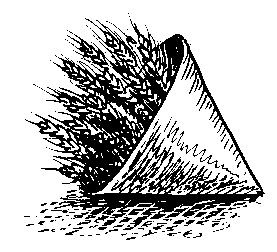 of dark paper (see the picture). Hand-perceivable emanations from the ears
repel the straw indicator of this device through any screens even harder
than some honeycombs. This effect is produced by multiple wedge-shaped
sinuses between ear scales, which are directed at an acute angle toward
the bottom of the ear.
of dark paper (see the picture). Hand-perceivable emanations from the ears
repel the straw indicator of this device through any screens even harder
than some honeycombs. This effect is produced by multiple wedge-shaped
sinuses between ear scales, which are directed at an acute angle toward
the bottom of the ear.
 distance and then it was pushed by hand toward the first one. When at
about 8cm, the first stem begun to move away from the second stem along
the edge. This experiment wasn't always successful, but it usually
occurred immediately after cutting of large amount of grass from the same
place. I forgot some elements or conditions of the experiment but, I think
that the following factors were at work here. An abrupt change of the
total CSE field on the "deformed" meadow (let us remember the tree
windfall case), the grid of the harvester's fingers, the multi-cavity
properties of the stem itself and perhaps its position against the morning
sun. Static electricity is excluded because everything at that hour is
wet. [grass used to be mowed with the morning dew still on it]
isklyuchaetsya: vse vokrug v `etot chas mokroe...
distance and then it was pushed by hand toward the first one. When at
about 8cm, the first stem begun to move away from the second stem along
the edge. This experiment wasn't always successful, but it usually
occurred immediately after cutting of large amount of grass from the same
place. I forgot some elements or conditions of the experiment but, I think
that the following factors were at work here. An abrupt change of the
total CSE field on the "deformed" meadow (let us remember the tree
windfall case), the grid of the harvester's fingers, the multi-cavity
properties of the stem itself and perhaps its position against the morning
sun. Static electricity is excluded because everything at that hour is
wet. [grass used to be mowed with the morning dew still on it]
isklyuchaetsya: vse vokrug v `etot chas mokroe...